West Coast Travel Guide
South Africa's sunny West Coast offers a wealth of exciting sights, excursions, and activities to visitors, and is the ideal place for those who plan on renting a car and road tripping in the country. The destination encompasses a wide range of geographical regions, and its relatively compact size means that they can all be explored in a single holiday.
The spectacular Atlantic coastline offers excellent water sport opportunities at Blaauwberg and Langebaan, and tranquil seaside towns such as Paternoster, Saldanha Bay, and Yzerfontein, all of which are famous for their Mediterranean atmosphere and fresh seafood.
The Swartland, the wheat and wine-producing region of the West Coast, is home to the charming town of Darling. Further inland, the Cederberg is a nature-lovers paradise, a world-famous ecotourism destination replete with national parks and camping sites, rock-climbing adventures and hiking trails.
The West Coast is also known as Namaqualand, where every year in spring (September), the landscape is over-run by gorgeous wildflowers. The Namaqualand Daisies, as they are commonly known, were featured in BBC's series and are a deservedly world-famous tourist attraction.
Visitors from all over the globe gawk at the incredible fields of colour. Apart from this splendidly colourful annual display, the West Coast is largely arid, with little shade on offer. Luckily, the freezing cold ocean promises refreshment.
Things to do in West Coast
The West Coast of South Africa is full of some of the country's best sights and activities. It serves as a great destination for those with a limited amount of time in South Africa, but who still wish to experience a good selection of what the country has to offer. They can fly into Cape Town, rent a car, and head out on the R27 for the adventure of a lifetime.
Many of the little towns along the arid coastline are quite eccentric, with distinct characters, and off-beat charm. Favourite stops include Langebaan, the West Coast National Park, Yzerfontein, the Cederberg, the Cape Columbine Nature Reserve, Saldanha, Paternoster, and Darling.
These destinations are all good for a few days of relaxation, but none of them are likely to keep visitors occupied for long. The best way to experience the region is to drive between towns, enjoying anything between a few hours to a few days in each according to preference.
The route is wonderful for surfers and other wind and water sport enthusiasts, but those wanting to partake in these fun activities should note that the sea is very cold along the West Coast and wetsuits are a necessity. It is also very important to take lots of sunscreen as there is little shade along this coastline and the sun can be fierce.
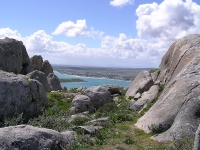
Langebaan
Located just 75 miles (120km) from Cape Town, Langebaan languished for years in relative obscurity, remaining an excellent retirement destination and a popular place for local fishing enthusiasts to spend the weekend. However, in recent years, picturesque Langebaan has been getting the attention it deserves and has become a frequented West Coast tourist destination. It offers an incredible range of fun water sports and adventure activities, as well as top-class beach resort accommodation and a winning selection of restaurants and shops. The water in the Langebaan Lagoon is warm enough to swim in all year round.
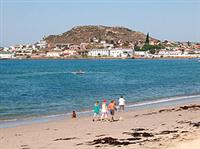
Saldanha
Saldanha is a small, attractive town situated on the northern shore of Saldanha Bay. The deep natural harbour sustains the area's economy and provides countless water sport and fishing opportunities to visitors. Saldanha Bay's fishing industry is underpinned by the export of delicacies such as crayfish, mussels, and oysters. This fine selection of seafood naturally characterises the town's gastronomy. Visitors can look forward to a range of fun activities, including kite-surfing, waterskiing and deep-sea diving. The area is also immensely popular with game-fishing devotees, who can entice yellowtail, tuna, and snoek from the ocean depths. Accommodation in Saldanha is plentiful, catering to luxury resort clientele as well as backpackers.
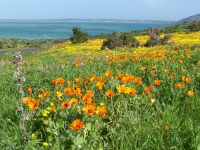
West Coast National Park
Located just 70 miles (110km) north of Cape Town, the West Coast National Park showcases the very best of the region's natural beauty. The attraction stretches from the quaint seaside town of Yzerfontein to the turquoise-blue Langebaan Lagoon, and stands out among South Africa's celebrated national parks. It is most famous for its bird life, with thousands gracing the rocks on its golden beaches, and thousands more filling the park's salt marshes with their varied songs and warbles. However, the West Coast National Park is also home to some interesting wildlife, including eland, red hartebeest, and caracal. The Postberg section is an excellent place to view Namaqualand Daisies when the countryside becomes carpeted in bright wildflowers during August and September.
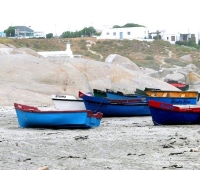
Paternoster
Paternoster is a quaint fishing village outside Cape Town. Its name comes from the prayers of shipwrecked Portuguese sailors who fell afoul of its rugged coastline. These days, many consider it the ideal West Coast beach-holiday destination. The first thing visitors will notice are the rows and rows of whitewashed fisherman houses: a lovely, and incredibly photogenic, architectural quirk that will linger long in the memory. A holiday in Paternoster is probably best taken at a snail's pace, meaning visitors will enjoy taking long walks on the fine sandy beaches and observing the region's bird life. For active types, hiking trails, mountain biking, sea kayaking, diving, and spearfishing excursions are available. The West Coast gets extremely hot but the freezing seawater will certainly cool visitors down.
Yzerfontein
Yzerfontein is about an hour outside Cape Town, and is the ideal getaway for those seeking a serene beach holiday. Along with its sunshine and mild winters, the tranquil seaside village is much loved for its Sixteen Mile Beach, which connects it to the Postberg conservancy area in the West Coast National Park. Travellers who venture to the park in August and September will see Namaqualand's wildflowers bloom in fabulous explosions of colour. Yzerfontein visitors can also enjoy fishing, hiking, skiing, mountain biking and whale watching. Only the brave are likely to swim in the region's very cold sea.

Darling
Darling is a fast growing tourist destination in South Africa. From the second visitors pull into this dusty station town, they'll understand exactly why. Located in a valley of golden hills in the Swartland region of South Africa's West Coast, Darling is a thoroughly charming spot with a local brewery and opportunities to go olive and wine tasting. Although Darling offers high-quality dining options, the town's main claim to fame is its most famous resident, satirist Pieter-Dirk Uys. He is perhaps better known by his alter-ego: Evita Bezuidenhout. Pieter-Dirk Uys has invested lots of time and energy in Darling, creating not only a popular cabaret venue (Evita se Perron), but also founding the Darling Trust: an organisation that promotes social upliftment through the arts.
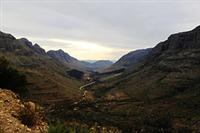
The Cederberg
When the film version of JM Coetzee's celebrated novel Disgrace was made, the film-makers controversially opted to ditch the book's original Eastern Cape setting in favour of various locations in and around the Cederberg: a mountainous conservancy area about 190 miles (300km) north of Cape Town. Their reasoning for this was simply that the Cederberg is one of the most beautiful, unspoilt areas of South Africa and that foreign audiences deserved to see this often-overlooked natural wonderland in all its glory. No doubt aided by this exposure, the Cederberg has quickly grown into one of the leading ecotourism destinations in Southern Africa. It is the premium destination for those outdoor adventurers looking to explore South Africa's unique and varied landscape.
South Africa travel info
Electricity
The electrical current is 230 volts, 50Hz. Round, three-pin plugs and round, two-pin plugs are standard.
Language
South Africa has 11 official languages, including Afrikaans, English, Xhosa, Zulu, and Sotho. English is widely spoken.
Money
South Africa's currency is the Rand (ZAR), which is divided into 100 cents. Money can be exchanged at banks, bureaux de change, and the larger hotels. ATMs are widely available and major international credit cards are widely accepted. Visitors should be vigilant when drawing cash from ATMs, as con artists are known to operate there. All commercial banks will exchange foreign currency. hello
Tipping
Tips of at least 10 percent are expected for good service if a service charge is not included in the bill. Tipping for services rendered is widely anticipated by porters, taxi drivers and petrol attendants. Golf caddies should be tipped accordingly. 'Car guards' operate in the city centres and tourist spots and will offer to look after parked cars; they are usually immigrants from neighbouring countries looking for work and will expect anything from ZAR 8 upwards on the driver's return, depending on how long the driver will have been away.
Health
Travellers from areas infected by yellow fever must carry a vaccination certificate; otherwise no vaccinations are required. There is a malaria risk in the low-lying areas of the Northern Province and Mpumalanga (including the Kruger National Park), as well as northeastern KwaZulu-Natal, and precautions are advised when travelling to these areas, especially between October and May. Vaccinations are recommended for hepatitis A, hepatitis B and typhoid. Tap water is generally safe in urban areas but sterilisation is advisable elsewhere. Medical facilities in South Africa are good in urban areas, but medical insurance is strongly advised as private hospitals expect cash up front and public hospitals are best avoided. Medication is readily available in major cities, but those travelling outside of these centres for an extended period should bring a basic supply kit for emergency self-treatment.
Safety
It is worthwhile noting that the South African authorities give high priority to the protection of tourists and that, although crime rates are high, popular tourist sites and the main hotel areas tend to be safe. Still, travellers should remember that violent crime tends to be concentrated in pockets throughout the country and travellers should do some research to find out which areas to avoid. For instance, Berea and Hillbrow in Johannesburg are high-risk areas, and township areas in general are dangerous for foreigners.
There is a risk of petty, opportunistic crime in all urban areas and armed robberies are fairly common in Johannesburg. Travellers should always be aware of these risks and exercise the necessary precautions. Carjackings and smash-and-grab robberies are common in major cities. Doors should be locked when driving; bags and valuables should be kept out of sight. Travellers should not walk alone at night in any area, and should be vigilant when using ATMs. They should not display signs of wealth (mobile phones, money, expensive jewellery, cameras) on the streets. Credit card fraud is on the increase, meaning travellers should be vigilant and never allow their card out of their sight.
Nationwide power cuts (loadshedding) take place regularly, occurring many times a day for multiple-hour stretches. There is some risk that outages might interfere with telecommunications and security systems, hotels and other accommodations, as well as public lighting and traffic lights. Visitors can plan for power cuts by asking their accommodation provider how they mitigate loadshedding, and by checking planned power outages on the Eskom website or loadshedding apps. They can also carry a power bank with extra charging cables for electronic devices they need, and pack portable lighting such as torches.
Local customs
South African culture and etiquette in urban areas is very Western. While standards of dress vary, beachwear should generally not to be worn off the beach, and nude sunbathing is only permissible in a few designated areas. Homosexuality is legal and accepted in urban areas without much fuss, but is frowned on by some conservative South Africans and can be a problem in township areas. Although locals may complain loudly about the country and government, they will take offense if a foreigner is critical. Racism is a sensitive issue; however, interracial relationships are now common and widely accepted. South African racial terminology differs from what is acceptable in North America. The terms 'black' and 'white' are appropriate for those of African and Caucasian descent, respectively. 'Coloured' refers not to black Africans, but those of mixed African and European descent and is not considered an offensive term. South Africans are friendly and hospitable, and will often go out of their way to assist tourists who need help.
Doing business
Business practices in South Africa are influenced by South Africa's range of ethnicities, languages and even geographical areas, but in general follow common patterns. When doing business in South Africa it's important to be culturally sensitive and as understanding of colleagues' historical context as possible. Most South Africans prefer to do business with contacts they've met before, but they are also warm and open to newcomers. Working to build and maintain business relationships is vitally important in the South African business environment. South Africans are renowned for their friendliness, which generally supersedes business formality.
Most large corporations, as well as the banking and financial sector, still adopt relatively formal business practices, whereas other companies and work environments enjoy more relaxed and personable atmospheres. Clear management hierarchies and respect for senior executives and colleagues are of paramount importance. However, business exchanges and decision-making processes often take on an egalitarian aspect. As with most countries, punctuality is highly regarded, though government officials are notorious for their tardiness when it comes to keeping time. Dress codes tend to be conservative, but not overly formal. Suits are the exception more than the rule, but dressing stylishly will always count in a visitor's favour. It's best to dress formally for initial meetings.
South Africans value hard work and respect those who succeed, but are mindful of other aspects of life such as healthy living, family and nurturing relationships, all of which add up to a well-balanced life. Generally South Africans are regarded as relaxed and informal with regards to introductions and the handling of business cards. Shaking hands is common for both men and women. The giving of gifts is uncommon and unnecessary.
The official language of business in South Africa is English, and business hours tend to start at 8:30am or 9am and the day comes to a close at 5pm, or later in the major urban centres. Working over weekends tends to be quite rare in South Africa.
Duty free
Travellers to South Africa do not have to pay duty on 200 cigarettes, 20 cigars and 250g of tobacco; 2 litres wine and 1 litre spirits; perfume up to 50ml and 250ml eau de toilette; and other goods to the value of ZAR 5,000 per person.
Communications
The international access code for South Africa is +27. Mobile phone networks are available across the country, and there are roaming agreements with most international mobile operators. Mobile service providers offer very cheap 'pay-as-you-go' SIM cards, which are a good option for visitors staying for some time. Alternatively, travellers can use eSIMs if their cellular providers support it on their networks. WiFi is easily available, especially in the larger cities.
Passport & Visa
Passports should be valid for at least 30 days beyond the period of intended stay. An onward or return ticket is required, as is evidence of sufficient funds. Extension of stay for an additional 90 days is possible if travellers apply at least 60 days prior to the expiry date of their visa, permit or visa exempt period. There are special requirements for travelling to South Africa with children under the age of 18, and different requirements for unaccompanied children entering the country. Travellers should consult the nearest South African high commission or embassy for details. It is highly recommended that travellers' passport have at least six months' validity remaining after the intended date of departure from their travel destination. Immigration officials often apply different rules to those stated by travel agents and official sources.
Entry requirements
United States nationals need a passport valid for at least 30 days beyond intended travel. A visa is not required for stays of 90 days.
UK nationals need a passport valid for 30 days beyond the date of intended travel, but no visa is needed for stays of up to 90 days.
Canadian nationals need a passport valid for 30 days beyond the date of intended travel, but no visa is needed for stays of up to 90 days.
Australian nationals need a passport valid for 30 days beyond the date of intended travel, but no visa is needed for stays of up to 90 days.
Irish nationals require a passport valid for 30 days beyond intended travel, but no visa is needed for stays of up to 90 days.
New Zealand nationals require a passport valid for 30 days beyond intended travel. A visa is not required for stays of up to 90 days.
Useful contacts
South African Tourism, Johannesburg: www.southafrica.net
Emergencies: 10111 (Police), 10177 (Ambulance), 10112 (cellphone emergency number).Embassies / consulates in other countries
South African Embassy, Washington, United States: +1 202 232 4400.
South African High Commission, London, United Kingdom: +44 20 7451 7299.
South African High Commission, Ottawa, Canada: +1 613 744 0330.
South African High Commission, Canberra, Australia (also responsible for New Zealand): +61 2 6272 7300.
South African Embassy, Dublin, Ireland: +353 1 661 5553.
Embassies / consulates in South Africa
United States Embassy, Pretoria: +27 12 431 4000.
British High Commission, Pretoria: +27 12 421 7500.
Canadian High Commission, Pretoria: +27 12 422 3000.
Australian High Commission, Pretoria: +27 12 423 6000.
Irish Embassy, Pretoria: +27 12 452 1000.
New Zealand High Commission, Pretoria: +27 12 435 9000.



